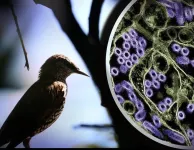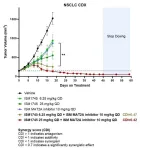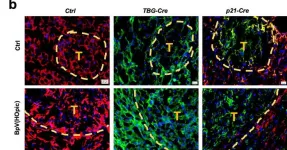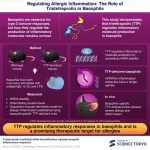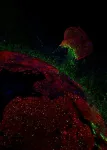(Press-News.org) WHAT:
Highly pathogenic H5N1 avian influenza A virus (HPAI H5N1) remains a low risk to the general public, and public health experts in the United States believe that available treatments and vaccines, as well as those in development, are sufficient to prevent severe disease. However, the National Institutes of Health (NIH) and its federal partners remain focused on monitoring the virus and evaluating changes, according to leading officials at the National Institute of Allergy and Infectious Diseases (NIAID), part of the NIH.
In a commentary published in the New England Journal of Medicine, NIAID Director Jeanne M. Marrazzo, M.D., M.P.H., and Michael G. Ison, M.D., M.S., chief of the Respiratory Diseases Branch in NIAID’s Division of Microbiology and Infectious Diseases, say people should find a balance between enhanced vigilance and “business as usual” with respect to HPAI H5N1.
Since 1996, HPAI H5N1 influenza viruses have circulated in at least 23 countries. In late 2021, HPAI H5N1 spread from Europe to North America causing sporadic infections among wild birds and poultry farms. In 2022, the virus spread to South America where it devastated birds and marine mammals. In March 2024, USDA scientists identified HPAI H5N1 in U.S. dairy cows, and it subsequently reached herds in 16 states. The virus has been detected in dairy herds in three states over the past 30 days, according to USDA/APHIS. In 2024, the virus has caused 66 confirmed and 7 probable cases of influenza in people in the U.S. and one case in Canada. These human cases have been caused by either the H5N1 type circulating in birds (D1.1) or the type circulating in dairy cows (B3.13).
Against this backdrop, Drs. Marrazzo and Ison say there are four keys to controlling the current outbreak. The first imperative is timely, effective collaborations among investigators in human and veterinary medicine, public health, health care, and occupational workers, such as dairy and poultry workers.
This involves cultivating trust not only between numerous entities, but with people seeking care for symptoms of concern, including conjunctivitis, the authors write. Fortunately, so far most U.S. cases of HPAI H5N1 have been mild and resolved on their own without the need for treatment.
Their second key is a focus on the Canadian HPAI H5N1 patient, who developed respiratory failure and required life-saving medical intervention and treatment before recovering. The authors write that mutations found in the virus in this patient highlight an urgent need for vigilant disease surveillance to identify and assess viral changes to evaluate the risk for person-to-person transmission. Effective surveillance, they say, requires that complete genomic sequencing data from animals and people are made rapidly and readily available.
Without information pertaining to where and when isolates were collected, the data cannot be linked phylogenetically to other reported sequences, limiting insight into how the virus is spreading, they write. These data would also provide opportunity for early detection of mutations that might portend avidity for human respiratory epithelium, which may require as little as one mutation in the virus.
Third, researchers must continue to develop and test medical countermeasures—such as vaccines and therapies that eliminate or alleviate disease—against H5N1 and other influenza viruses. Fortunately, current vaccine candidates neutralize the circulating strains, which so far are susceptible to antivirals that could mitigate transmission and severity of illness, they write.
Lastly, Drs. Marrazzo and Ison encourage people to take precautions to prevent exposure to the virus and minimize the risk of infection. For example, people who work with poultry and cows should use personal protective equipment and educate themselves about occupational risks when working with birds and mammals, as CDC and USDA have repeatedly recommended.
Ideally, following these four steps will help scientists and public health officials investigating HPAI H5N1 to answer the many remaining questions more quickly about how the virus is spreading, evolving, and affecting people, other mammals, and birds.
ARTICLE:
M Ison and J Marrazzo. The Emerging Threat of H5N1 to Human Health. NEJM DOI: 10.1056/NEJMe2416323 (2024).
WHO:
NIAID Director Jeanne M. Marrazzo, M.D., M.P.H., and Michael G. Ison, M.D., M.S., chief of the Respiratory Diseases Branch in NIAID’s Division of Microbiology and Infectious Diseases, are available for comment.
CONTACT:
To schedule interviews, please contact Ken Pekoc, (301) 402-1663, kpekoc@niaid.nih.gov.
NIAID conducts and supports research—at NIH, throughout the United States, and worldwide—to study the causes of infectious and immune-mediated diseases, and to develop better means of preventing, diagnosing and treating these illnesses. News releases, fact sheets and other NIAID-related materials are available on the NIAID website.
About the National Institutes of Health (NIH): NIH, the nation's medical research agency, includes 27 Institutes and Centers and is a component of the U.S. Department of Health and Human Services. NIH is the primary federal agency conducting and supporting basic, clinical, and translational medical research, and is investigating the causes, treatments, and cures for both common and rare diseases. For more information about NIH and its programs, visit http://www.nih.gov/.
NIH...Turning Discovery Into Health®
END
University of Iowa researchers are recommending all patients be surveyed about their physical activity levels, after a new study underscores the link between physical activity and chronic disease.
The study, led by Lucas Carr, associate professor in the Department of Health and Human Physiology, examined responses from more than 7,000 patients at University of Iowa Health Care Medical Center who noted their level of physical activity in a questionnaire.
From patients’ answers to the questionnaire, the researchers found that those who reported the highest level of physical activity — meaning they exercised moderately ...
Since 2021, Insilico Medicine has successfully nominated 22 preclinical candidates (PCCs) with the help of its proprietary Pharma.AI platform, among which 5 were nominated just the year of 2024.
The novel scaffold of ISM1745 is based on de novo generation results of Insilico’s Chemistry42, the generative AI platform combining more than 40 generative models.
With in vivo anti-tumor activity validated in multiple cancer models, the candidate compound showed robust in vivo efficacy as monotherapy as well as combination potential with chemotherapies, targeted agents including MAT2A inhibitor, and immunotherapies.
CAMBRIDGE, ...
Scientists at University of California San Diego School of Medicine have shed new light on the development of liver cancer, the sixth most frequently diagnosed cancer and fourth leading cause of cancer deaths worldwide. The study, published in Nature, reveals a complex interplay between cellular metabolism and DNA damage that drives the progression of fatty liver disease to cancer. The findings suggest new paths forward for preventing and treating liver cancer and have significant implications on our understanding of cancer’s origin and the effects of diet on our DNA.
The incidence of the most common form of liver cancer, hepatocellular carcinoma (HCC), has grown by 25-30% in the past ...
Inflammation is a crucial part of the body’s defense mechanism, playing a key role in fighting infections and repairing tissue damage. Basophils, a type of immune cell that makes up less than 1% of white blood cells, have recently emerged as critical players in triggering allergic responses by releasing pro-inflammatory cytokines like IL-4. Despite the established role of basophils in inflammation, the molecular mechanisms controlling their cytokine production have remained unclear.
To address this gap, a group of researchers from Institute of Science Tokyo, led by Professor Kensuke Miyake, conducted a study to explore the role of tristetraprolin ...
Researchers are aiming to bring the magic of playing music in person to the virtual world.
The Joint Active Music Sessions (JAMS) platform, created at the University of Birmingham, uses avatars created by individual musicians and shared with fellow musicians to create virtual concerts, practice sessions, or enhance music teaching.
Dr Massimiliano (Max) Di Luca from the University of Birmingham explains: “A musician records themselves and sends the video to another musician. The software creates a responsive avatar ...
One or two doses of psilocybin, a compound found in psychedelic mushrooms, may improve the mental health of cancer patients when accompanied by psychotherapy, a new report suggests. A second new study found that treatment with psilocybin resulted in lasting, positive personality changes in patients with alcohol use disorder.
The first report’s findings were published online Oct. 7 in the journal Nature Mental Health, and the second published online Jan. 1 in a special edition of The American Journal of Psychiatry focused on psilocybin research.
In the first study, a team of experts at NYU Langone Health found that psilocybin accompanied by psychotherapy significantly reduced anxiety, ...
To many, Vice President Kamala Harris’s loss in the 2024 presidential election was a sobering reminder of a larger and continuous gender gap across leadership positions in not only government, but also in business, higher education, and the military. A majority of Americans recognize the inadequacy of female representation in leadership, and the news media often portray women’s underrepresentation in these roles—but it nonetheless persists.
Recognizing that news coverage may have influence in forming attitudes and in driving ...
A new international study led by researchers at Karolinska Institutet in Sweden shows that AI-based models can outperform human experts at identifying ovarian cancer in ultrasound images. The study is published in Nature Medicine.
“Ovarian tumours are common and are often detected by chance,” says Professor Elisabeth Epstein at the Department of Clinical Science and Education, Södersjukhuset (Stockholm South General Hospital), at Karolinska Institutet and senior consultant at the hospital’s Department of Obstetrics and Gynecology. “There is a serious shortage of ultrasound experts in many parts of the world, which has ...
Researchers from the Bakkers group at the Hubrecht Institute have successfully repaired damaged mouse hearts using a protein from zebrafish. They discovered that the protein Hmga1 plays a key role in heart regeneration in zebrafish. In mice, this protein was able to restore the heart by activating dormant repair genes without causing side effects, such as heart enlargement. This study, supported by the Dutch Heart Foundation and Hartekind Foundation, marks an important step toward regenerative therapies to prevent heart failure. The findings were published in Nature Cardiovascular Research on January 2, 2025.
After a heart attack, the human heart loses millions of muscle cells that cannot ...
Artificial intelligence tools such as ChatGPT have been touted for their promise to alleviate clinician workload by triaging patients, taking medical histories and even providing preliminary diagnoses.
These tools, known as large-language models, are already being used by patients to make sense of their symptoms and medical tests results.
But while these AI models perform impressively on standardized medical tests, how well do they fare in situations that more closely mimic the real world?
Not that great, according to the findings of a new study led by researchers at Harvard Medical School and Stanford University.
For their analysis, published Jan. 2 in Nature ...
